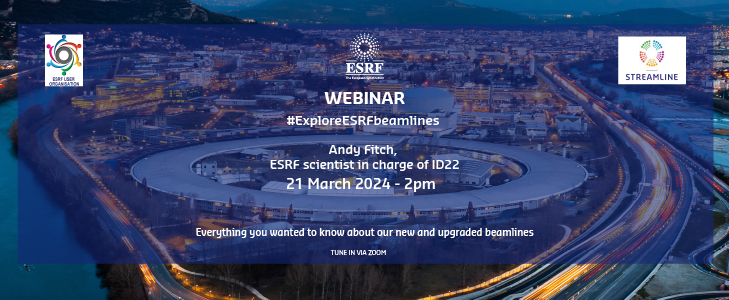EXPLORE ESRF BEAMLINES - ID22 High-Resolution Powder Diffraction Beamline - Andy Fitch

ID22 High-Resolution Powder Diffraction Beamline -
ESRF scientist in charge of ID22 - Andy Fitch ABSTRACT
The ESRF has operated a high-resolution powder diffraction beamline for users since May 1996. Originally built on bending magnet BM16, the beamline has been relocated twice, to ID31 in 2002, and to ID22 in 2014. Following the EBS upgrade, ID22 has been equipped with a u26 in-vacuum undulator, giving X-rays in the range 6-75 keV (l » 2.07-0.165 Å). Measurements are routinely made at 0.354 Å (35 keV) unless there is a specific need to measure elsewhere. This relatively high energy for powder diffraction studies means that essentially all samples can be measured in a spinning thin-walled glass capillary, thereby reducing potential problems associated with preferred orientation. The diffractometer’s nine-channel Si 111 multi-analyser stage has also been upgraded to a thirteen-channel version with a Dectris Eiger2 X 2M-W CdTe pixel detector that receives the X-rays transmitted by the analyser crystals. By exploiting the axial resolution this imparts to the measurements, the peak-shape asymmetry that occurs at low diffraction angles for high-resolution measurements has been eliminated leading to higher angular resolution than previously possible, and improved statistical quality at higher diffraction angles.
Typical applications include solving and refining of crystal structures using high-resolution data, and the study of short-range ordering in poorly-crystalline materials with pair distribution function (PDF) analysis via measurements to high Q, (4psin𝜃/l), exploiting the short-wavelength radiation available. A complementary 41×41 cm2 Perkin Elmer medical imaging detector is also available for faster (but lower angular resolution) measurements for PDF (or texture) analysis. Sample environments are an important aspect of ID22’s operation. Powder patterns can be collected as a function of temperature, time, gas pressure, atmosphere, voltage, etc. Measurements on capillary specimens are possible in the range of 4 K to 1600°C, or under non-corrosive gas atmospheres in the range 0 to 100 bar, e.g. following the adsorption of CO2 in a porous material such as a zeolite or metal-organic framework. The beamline is also equipped with an automatic sample changer, allowing a series of up to 75 samples to be run with temperature control in the range 80 K to 950°C. High resolution data means that complex mixtures, maybe containing phases in very low concentrations, are more amenable to qualitative and quantitative analysis. The tunability allows the wavelength to be selected close to an element’s absorption edge to exploit anomalous scattering, to help distinguish neighbouring elements in the Periodic Table with similar scattering power, or away from edges to minimize absorption from a sample and obtain maximum intensity.
More details can be found in:
Fitch A. et al. "ID22–the high-resolution powder-diffraction beamline at ESRF." Journal of Synchrotron Radiation 30.5 (2023): 1003-1012.



